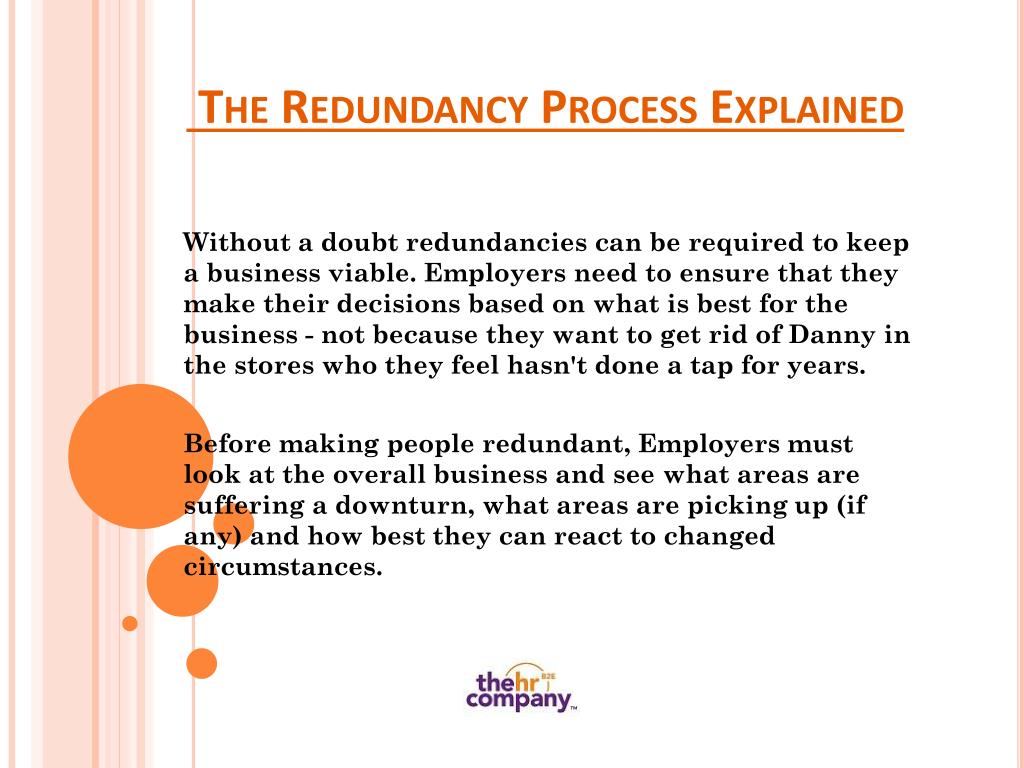Who Pays Redundancy Money? A Detailed Overview for Employers and Employees
Who Pays Redundancy Money? A Detailed Overview for Employers and Employees
Blog Article
Examining the Interaction In Between Company Redundancy and Business Versatility for Future Growth
In the vibrant landscape of today's company world, the elaborate relationship between firm redundancy and organizational adaptability emerges as a vital aspect for sustained development and success. Companies commonly deal with the obstacle of striking a fragile balance between maintaining a level of redundancy to reduce risks and promoting flexibility to react promptly to the ever-evolving market needs.
Value of Company Redundancy
Company redundancy is an important component that enhances organizational strength and reduces functional threats. By including redundancy measures within the organizational structure, business can much better stand up to unforeseen interruptions and variations in business environment. Redundancy functions as a critical barrier, permitting firms to adapt and respond properly to unexpected challenges without compromising necessary procedures.
One key aspect of the relevance of company redundancy is its duty in guaranteeing connection during times of crisis. When encountered with sudden modifications or emergencies, repetitive systems, resources, or employees can action in to maintain crucial features and prevent prevalent interruptions. This continuity not just safeguards the business's track record and consumer trust yet also minimizes monetary losses and operational downtime.

Techniques for Business Versatility

Developing adaptable organizational frameworks that permit for fast adjustments to market dynamics and customer requirements is essential for staying competitive in a rapidly progressing atmosphere. By proactively determining potential disturbances and opportunities, companies can proactively thrive and adapt in an ever-changing organization landscape.
Harmonizing Redundancy and Versatility
Attaining a harmonious balance in between functional redundancy and business adaptability is extremely important in navigating the intricacies of a dynamic service setting. Redundancy within a firm provides a security web, guaranteeing continuity and stability in operations. Nonetheless, an extra of redundancy can cause inadequacies and prevent flexibility to changing market problems. On the other hand, organizational versatility allows companies to react promptly to exterior disturbances and take new chances. Striking the appropriate balance in between redundancy and flexibility is a delicate process that requires a deep understanding of the company's goals, industry dynamics, and risk resistance.
To attain this balance, companies need to perform routine assessments of their procedures to identify locations where redundancy is necessary for danger mitigation and where versatility can drive development and growth. Implementing flexible structures, promoting a society of constant learning and important site renovation, and motivating open communication across all degrees of the organization are essential strategies to harmonize redundancy and flexibility successfully. By straightening these 2 critical components, companies can position themselves for lasting growth and success in an ever-changing organization landscape.
Case Researches on Adjustment Success
In taking a look at instances of effective business adaptation, it comes to be noticeable that the interaction in between functional redundancy and versatility is a specifying consider shaping durable organizations. One compelling study is that of Netflix. Initially a DVD rental service, Netflix showed exceptional adaptability by transitioning into a streaming system when digitalization disrupted the industry. By strategically purchasing technology and web content development, Netflix not only survived yet grew in a swiftly evolving market. An additional standout instance is Amazon. Starting as an online bookstore, Amazon continuously adjusted its service version, broadening into diverse industries such as cloud computing and synthetic knowledge. This flexibility allowed Amazon to stay ahead of rivals and meet changing customer demands. Last but not least, Adobe supplies a notable illustration of effective adjustment. The firm moved from offering software application licenses to a subscription-based design, guaranteeing repeating earnings streams and enhanced consumer involvement. These study emphasize the importance of operational redundancy combined with business flexibility in fostering long-lasting development and competitiveness.
Building Strength for Future Development
Building strength for future growth needs browse around here a critical alignment of operational procedures with market dynamics and arising trends. Firms should adapt to altering environments by promoting a culture of flexibility, innovation, and continual renovation.
In addition, fostering strong connections with stakeholders, such as consumers, workers, providers, and the neighborhood, is important for keeping and weathering unpredictabilities trust fund and assistance during rough times. Efficient communication and openness play an essential role in structure strength, as they assist facilitate and align assumptions partnership in navigating uncertainties.
Furthermore, organizations require to focus on understanding and growth initiatives to upskill staff members and equip them with the essential tools to adapt to transforming scenarios. By investing in their labor force, companies can improve their versatility and agility, eventually reinforcing their strength for sustainable future growth.
Conclusion

In the vibrant landscape of today's company globe, the elaborate partnership in between firm redundancy and organizational adaptability emerges as a vital element for sustained development and success. Business usually face the difficulty of striking a fragile balance between keeping a level of redundancy to mitigate threats and cultivating versatility to respond promptly to the ever-evolving market needs.To accomplish this equilibrium, business require to carry out routine evaluations of their operations to recognize locations where redundancy is necessary for danger mitigation and where adaptability can drive advancement and development.In conclusion, the interaction in between firm redundancy and organizational versatility is essential for future growth. Building strength with a combination of redundancy and adaptability will certainly guarantee that business are prepared look at here for the difficulties of the future.
Report this page